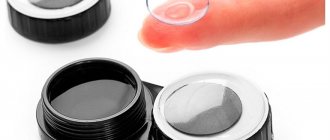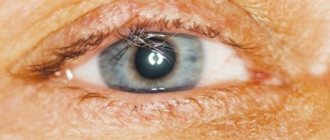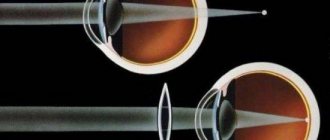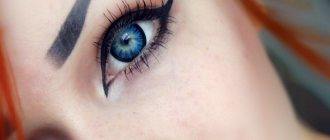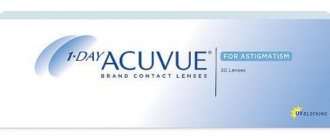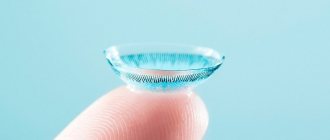What are hard contact lenses
Hard contact lenses (RCLs) were the first to appear on the ophthalmic products market. In the minds of consumers, they are associated with a lack of wearing comfort (corneal edema) and the difficulty of cleaning products after use.
New models are made of modern ophthalmic materials (silicone) and are called gas-permeable (breathable) lenses. Gas permeability is the main condition for comfortable wearing of contact products. Now the surface of the lenses does not deprive the cornea of air supply, which creates favorable conditions for the comfortable use of contact products.
Silicone allows oxygen to pass through perfectly. In this, it has an incomparable advantage over silicone hydrogel, from which soft contact models are created. Today, liquid contact lenses are safer for eye health than soft contact analogues.
But the most important feature is the correction of ophthalmological defects associated with changes in the shape of the cornea. If soft ones completely repeat the shape of the eyeball, then hard ones correct it and eliminate defects.
The selection of hard lenses is carried out by a highly qualified ophthalmologist after a comprehensive examination of the visual organs. The doctor measures the parameters of the cornea, checks visual acuity and performs other necessary tests. Only after this can you select finished products or make an individual order. A week later, the patient returns to the ophthalmologist to evaluate any imaging problems.
Opportunities of our center
In our contact vision correction department, we have the ability to select and individually manufacture rigid gas-permeable scleral contact lenses “Zenlens” even for advanced stages of keratoconus.
Comprehensive diagnostic examination for the selection of scleral lenses (primary) with consultation of a specialist - 5,500 rubles.
Selection of an individual scleral lens using OCT (optical coherence tomography) - 7,500 rubles.
Manufacturing of an individual rigid scleral contact lens (1 eye) - 12,900 rubles.
Advantages
- They ensure the stability of the picture when blinking, as they retain their shape well;
- less susceptible to deformation under mechanical stress;
- resistant to protein deposits;
- have a smaller diameter, which ensures access of oxygen to the mucous membrane of the eyeball and free flow of tear fluid;
- do not dry out at low air humidity and in the wind;
- characterized by a long service life.
So, LCDs turned out to be in many ways better than their soft counterparts. They do not distort the picture of the world when blinking, do not break or become deformed. Protein deposits are not deposited on them, which significantly saves processing time and increases the wearing period.
It is hard contact lenses that can improve visual acuity, in which hydrogel designs are inferior to them.
They never dry out like hydrogel ones because they do not contain water. This frees users from periodically moistening lenses with special liquids.
The designers have developed an ideal diameter of the GCL, which is slightly smaller than the diameter of the cornea. In this way, free tear exchange is not disrupted. The design of soft models completely covers the eye, preventing tears from washing the mucous membrane and eliminating dead cells. In ZhKL this disadvantage is completely eliminated by reducing the diameter.
LCDs can correct many vision defects, which cannot be achieved using soft structures. They are prescribed in the postoperative period, to correct scars after trauma to the mucous membrane, in the treatment of astigmatism and keratoconus, for senile farsightedness and in many other cases.
Flaws
These include:
- long adaptation period;
- incompatibility with glasses;
- limited wearing period;
- vulnerability to scratches;
- contraindications;
- high price.
Rigid gas-permeable lenses differ from hydrogel lenses in the long-term adaptation of the eyes. The first week there will be discomfort in the visual organs due to contact with the material. If you take a long break from using LCDs, you will have to get used to them again.
Why are LCDs incompatible with glasses? Because they change the shape of the cornea. When the patient puts on glasses after contact lenses, the image becomes blurry and indistinct. After a certain period of time, the shape of the cornea returns to its previous position, and the clarity of visualization in glasses is restored.
While hydrogel lenses immediately take the shape of the eyeball, rigid designs completely change the contours of the cornea. Therefore, patients spend a lot of time selecting models that match the shape of the eyeball. In most cases, hard lenses are made to order.
You can wear the LCD for no more than 18 hours. They must then be removed and placed in a container of lens solution. It is impossible to sleep in a liquid-contact lens, as the material may stick to the mucous membrane of the eye.
The hard and durable lens material does not protect them from scratches. This causes some inconvenience in use, since scratched models cannot be worn over the eyes.
GCL should not be worn by patients with:
- diabetes mellitus;
- glaucoma and tuberculosis;
- high blood pressure.
Hard lenses are strictly contraindicated for patients with tuberculosis. They can injure the mucous membrane, through which pathogenic bacteria can easily penetrate and cause various complications.
Patients with diabetes are deprived of sensitivity to pain, so they may not notice injury to the mucous membrane. This will lead to inevitable complications and unpleasant consequences. Therefore, the use of rigid structures for diabetes is prohibited.
It is also not recommended to wear a cold contact lens when you have a cold due to the increased irritability of the conjunctiva during the period of illness.
Night lenses
Designed specifically for use at night, as they do not come into contact with the corneal layer. Night lenses have only a passive effect on the cornea, excluding direct pressure. Therefore, the risk of material sticking to the mucous membrane is completely eliminated.
However, one should not hope to completely correct vision defects with night lenses: the effect lasts no more than a day.
Indications for use:
- athletes;
- working in smoky rooms;
- school age children;
- treatment of farsightedness/myopia.
Athletes, due to the specific nature of their activities, cannot use glasses during training. Therefore, the only way to correct vision is to wear night silicone lenses. The same applies to people working in smoky rooms. Constant dust and smoke damage the optics, so there is no point in wearing them during the day. Night correction replaces the use of daily patterns.
Patients who are prohibited from surgery on the visual organs can use night lenses to correct farsightedness/myopia. The same applies to schoolchildren. The use of glasses and daytime lenses during an active lifestyle is impossible, so the only way out is hard lenses at night to correct myopia/farsightedness. In children, visual organs are formed before the age of 17 and can be easily corrected with the help of night-time LCDs.
conclusions
As you can see, hard lenses for vision correction are a fairly comfortable to wear, safe and trouble-free type of optics that can correct your vision to the desired level in a few minutes. It has virtually no contraindications for wearing. Those patients who have been prescribed this type of correction only need to spend some time selecting lenses for their eyes and become familiar with the care and rules for wearing the samples. And then, within 2 weeks after purchase, these products will no longer cause you any inconvenience and will become the most convenient type of optics you have ever used.
Storage and care
The LCD should be removed and put on with pre-disinfected hands (wash with soap, treat with a disinfectant solution). After washing, hands should be thoroughly dried, but a lint-laden towel should not be used.
Unlike soft lenses, they do not require a scrupulous approach to operation and storage. The set of products for caring for residential areas is minimal. However, you need to buy a special liquid designed to store this optics.
Before immersing products in the solution, they are inspected for contamination. If the surface is contaminated with dust or tear deposits, cleaning is necessary. To do this, moisten a soft cloth in the solution and carefully wipe the products. Brushes or disinfectant solutions must not be used for the cleansing procedure.
You can also clean products with your index finger. Place the lens in the palm of your left hand, pour some liquid on it and gently wipe it with the index finger of your right hand. After this, rinse with the solution. If necessary, you can re-process the product followed by rinsing with the solution.
The solution for hard lenses is different from the liquids used to disinfect soft models. Its composition includes disinfecting, moisturizing, cleansing and lubricating components.
When cleaning liquid crystals, you should not use physical force or put pressure on the products. It is also prohibited to use heated solutions: the thermal effect changes the quality characteristics of the optics.
Is it possible to wash LCDs with warm tap water? This is strictly prohibited, since there are a lot of bacteria in ordinary water.
To remove protein deposits from tear fluid, solutions with enzymes are used. An ophthalmologist will tell you how to use these solutions.
A container for hard lenses is filled with a solution, and cleaned lenses are immersed in it. Make sure that the solution covers them on top. Always pour fresh liquid into the container: do not store optics in old solution.
Before filling the container with liquid, it is cleaned. When cleaning the container, it is prohibited to use tap water; liquid for cleaning and storing liquid crystals is used for these purposes. The container must be periodically replaced with another one so that it does not turn into a breeding ground for bacteria.
Bottom line
The advantage of rigid contact ophthalmic structures is the ability to correct significant defects in the corneal layer. Directly acting on the eyeball, LCLs gradually restore the deformed cornea and correct vision. With their help you can get rid of farsightedness/myopia, astigmatism and keratoconus.
Nighttime hard lenses have also become widespread, helping to get rid of visual defects during sleep. Night models are recommended for use by school-age children, athletes and some other groups of people. An active lifestyle does not allow the daytime use of contact corrective lenses, so nighttime models of hard lenses have become an excellent alternative to treatment.
Sources used:
- Surgery for refractive errors of the eye. Collection of scientific papers / ed. S.N. Fedorov. - Moscow: Russian State University for the Humanities, 1981.
- Modern ophthalmology. Management. - M.: Book on Demand, 2009.
- Eye diseases. A manual for a local doctor / V.N. Arkhangelsk. — M.: State Publishing House of Medical Literature
- The University of Chicago's Department of Ophthalmology and Visual Science
Specifics of wearing mode
Gas-permeable lenses, depending on the model, can have different wearing modes, in particular:
- daytime (up to 10 hours a day);
- extended wearing regime (from 5 days or more);
- night (a special type of wearing mode that provides orthocorrection).
Planned replacement of gas permeable lenses is usually carried out every three months or a year (which is more often recommended by manufacturers).
If the optics are damaged, as well as changes in visual acuity, it is recommended to replace the products unscheduled. To do this, you need to undergo a comprehensive diagnostic test again and transfer the new results to the company that produces the lenses for you.
